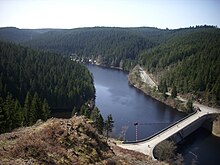Pre-lock

A pre- dam is a mostly smaller dam that is located in front of a dam to hold back impurities (tree trunks, oil, rubble, sediments) carried along by the tributaries, which is particularly important in systems for drinking water supply.
definition
Pre-locking and pre-pool
In terms of the meaning of the word, a pre-barrier is a barrier structure like the main barrier , in front of which the forecourt is located. The pre-dam and the pre-basin are one and describe two parts of the same dam. It would then be irrelevant whether there is still a piece of river between them and the main dam.
Definition of DIN
However, DIN 4048-1: 1987-01 (as of 10.2005) makes another attempt to standardize the terms pre- dam and pre-basin . According to the DIN, dams are to be designated as pre-dams that are located directly at the root of a dam where the river or stream flows into the dam. Fore basins are further away from the main and pre-dams upstream. A pre-barrier is located directly in front of the main basin and is separated from it by a barrier structure ( dam , dam ), which is also dammed on the air side . The reservoir level in the pre-dam is higher than or equal to that in the main basin. A pre-basin lies further above the main dam (or the pre-dam) with a section of the river in between.
Previous meanings
In the past, the terms were often used inconsistently, in addition to the definition above. Large pre-basins, even if they were located away from the main dam and were already the size of a dam, were sometimes called pre- dam . Insignificant small pre- barriers , on the other hand, were also referred to as pre-basins or dams . Sometimes they only have one passage without a build-up.
Further definitions
The difference named in DIN should be better defined with other expressions, for example:
- Forecourt, which is separated from the reservoir of the main dam by a preliminary dam and with it - at least at high water levels - forms a common storage space,
- Pre-basin, which is located a bit away from the main dam on the same course of the river and has a pre-dam as a barrier structure.
Purpose of pre-locking

Pre-dams and forebay are built, rubble Geschwemmsel keep out dirt and the like from the main pool. The water should be pre-cleaned, and any turbid substances will sediment. For an optimal pre-cleaning of the water, sufficient time is required in the front basin; Short-circuit currents directly into the main pool are to be avoided. The required size of a fore basin can be calculated depending on the inflow quantity, but the dimensions are mostly determined by structural conditions.
Depending on the conditions in the catchment area, fore basins can silt up due to sedimentation and then have to be dredged regularly. However, they reduce the sedimentation in the storage space of the main barrier.
Pre-locks remain permanently stowed at the level of the reservoir destination, while the main lock can have a changing water level. The constant water level in the fore basin results in completely different ecological conditions for the fauna and flora, which means that the fore basins often develop into biotopes that are placed under nature protection.
Underwater barriers
Pre-barriers, which are under water when the main reservoir is completely blocked, are also called underwater barrages.